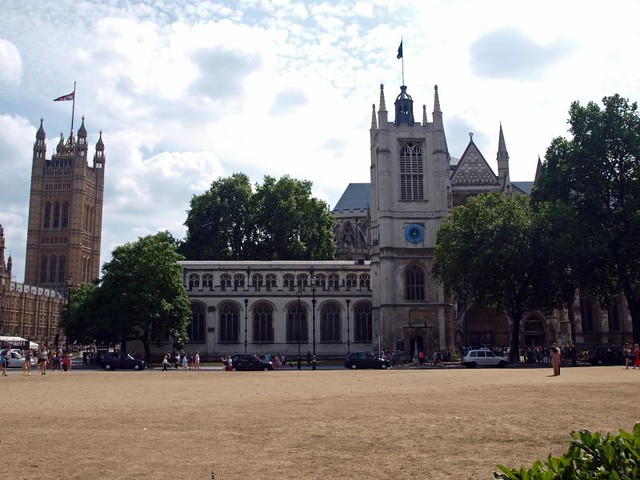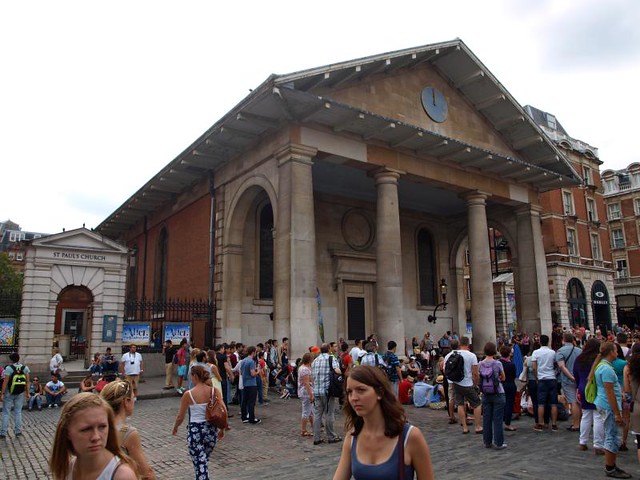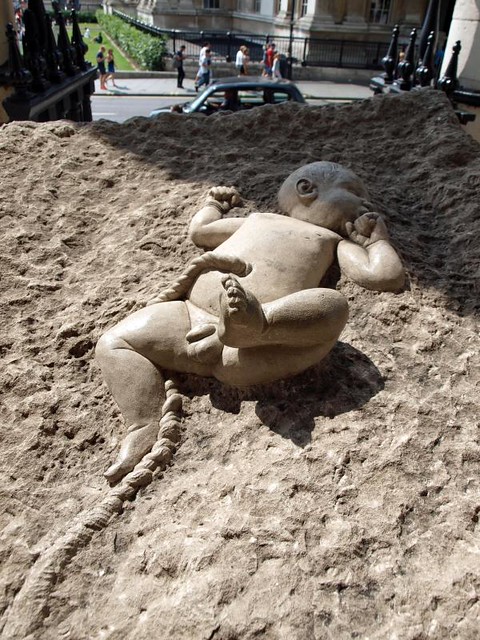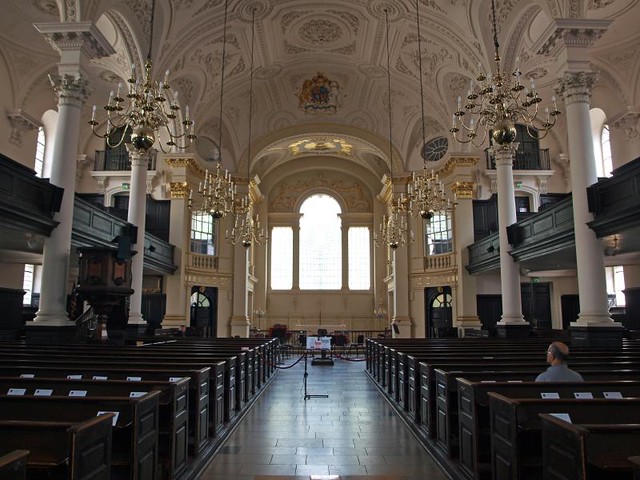The youngest had a hot date with one of his godmothers to see War Horse so I had a couple of hours to fill in London and, unusually, did some research. I already knew I wanted to visit St Martin in the Fields [qv] but baulked at Westminster Abbey's ludicrous £18 entry fee and ban on photography - if I visited with all my children it would cost me £83 just to gain entry. Fuck that...£18 when I can't take photos; what exactly are the poor saps who visit paying for
*?
So I researched St Margaret instead and found that photography was allowed and decided here was an opportunity that shouldn't be missed, only to find that photography is banned for these reasons (taken straight from the Abbey website but applies to St Margaret as well):
- It can disturb other visitors’ experience of the Abbey
- Flash photography is bad for conservation
- It holds up the movement of visitors when there are lots of people in the Abbey
- We have to be careful about and protect what the image of the
Abbey is used for - with digital photography and photoshop it is easy
for someone to use the image in a way that we aren't happy with or to
advertise or promote something
- We can't be sure what is for personal use and what is for professional
This is blatantly bullshit or else Ely, Peterborough, Salisbury, Bury St Edmund, Canterbury, St Albans and Chelmsford would follow the same policy - which they don't.
On the other hand if I could have recorded the interior I probably wouldn't have had time to do it properly since the interior is stuffed with monuments and good windows. So I had quick recce and headed off to St Martin.

To the south-west of the square, on the very lawns of Westminster Abbey sits, composed, demure and quietly self-confident, St Margaret’s church. Though claims have been made for its being an 11th-century foundation, its consecration most probably dates from the early 12th century. The present building was begun at the very end of the 15th century, to plans by Robert Stowell, master mason of the Abbey. The south aisle - the oldest part - was paid for by Dame Mary Billing, the widow of a Chief Justice; she died in 1499. The chancel was built in the early 16th century by John Islip, the last great Abbot of Westminster; his architects were Thomas and Henry Redman. They also built the tower, though the upper parts were rebuilt between 1735 and 1737 by John James. A porch was added by J. Loughborough Pearson in the late 19th century.
The church is chiefly famous for three things - for its association with the House of Commons, for its 16th-century east window, and for the number and variety of its monuments. It was first used by the House of Commons when a service of Holy Communion was held there on Palm Sunday, April 17, 1614. It had been planned to hold it in the Abbey but the more Puritanical Members of Parliament had a “feare of copes and wafer-cakes, and other such important reasons” and so it was held in St Margaret’s instead, and the association has continued ever since. The east window was made to celebrate the marriage of Prince Arthur, Henry VIII’s elder brother, with Katharine of Aragon, but this splendid example of Flemish glass arrived in England after the bridegroom’s death. It was sent to Waltham Abbey, and after that house was dissolved the window passed into private hands and was at last bought for St Margaret’s in 1758 by the House of Commons for 400 guineas. The three central lights show the Crucifixion with the two Thieves on either side of Christ, and in the upper halves of the two outer lights are St George and St Katharine. Beneath the saints kneel the young bride and bridegroom, whose marriage lasted barely five months. Beneath the window is the altar with a reredos which is a relief copy of Titian’s painting of Christ’s appearance at Emmaus; it was made by Siffrin Alken about 1757.
The chancel and nave have no structural division and are of nine bays. Around the walls are scores of small, intimate memorials. Chaucer, who was a parishioner, has no memorial here - he lies in the Abbey - but Caxton was buried here and has a tablet raised by later admirers. His shop was at the sign of the Red Pale and stood within the Abbey Almonry itself. Several of Elizabeth I’s most faithful servants lie here, chief among them perhaps being Blanche Parry, Keeper of the Queen’s Jewels, who died in February 1589 (i.e. 1590) aged 82, having looked after the queen since her birth. Lady Dorothy Stafford, who had served the queen for 40 years, died in 1605, and she is shown kneeling with three sons and three daughters beneath her, whilst Lady Mary Dudley, sister to Lord Howard of Effingham who commanded the English fleet against the Armada, has a fine full-length effigy. A bust in a roundel shows us Cornelius Van Dun, a Dutchman who served Henry VIII, Edward VI, Mary I and Elizabeth I as a Yeoman of the Guard and, dying in 1577 at the age of 94, did buyld for poor widowes 2 houses at his own cost. Among all these who had loved the queen is one great man, Sir Walter Raleigh. He fell out of favour with her successor, James I, and after a long imprisonment, was in 1618 executed in Old Palace Yard, in order to please the King of Spain. Raleigh’s courage on the night before his death was remarkable. During the dark hours, he wrote a poem:
Even such is time which takes in trust
Our yowth, our Ioyes and all we have,
And pays us butt with age and dust:
Who in the darke and silent grave
What we have wandered all our wayes
Shutts up the storye of our dayes.
And from which earth and grave and dust
The Lord shall raise me up I trust.
His headless body was buried under the High Altar at St Margaret’s, but his widow kept his head and it is not known whether it was ever re-united with his trunk. The west window in the church, made in the 19th century, has portraits of Raleigh and his half-brother, Sir Humphrey Gilbert, as well as Elizabeth I and Henry, Prince of Wales, James I’s eldest son, who admired Sir Walter and wanted to see him freed from prison. Had the prince lived, Raleigh’s fate might have been different.
Those who commanded during the Commonwealth lie here. After their bodies were exhumed with contumely from Westminster Abbey, Admiral Robert Blake, John Pym, Cromwell’s mother and daughter, and 19 others were buried in St Margaret’s churchyard. A later generation has raised a wall-plaque to Blake’s memory. It was in this church that the blind poet, John Milton, was married for the second time. His first marriage had been bitterly miserable but with Katherine Woodcock he was happy for a brief fifteen months. She died in childbed and their baby daughter only survived for six weeks; mother and child were buried together in the churchyard here. They had lived in a “pretty garden-house” in Petty France; Milton lived on alone and wrote:
Methought I saw my late espouséd saint
Come vested all in white, pure as her mind.
Her face was veiled, yet to my fancied sight
Love, sweetness, goodness in her person shined
So clear as in no face with more delight.
But O as to embrace me she inclined
I waked, she fled, and day brought back my night.
A window in Milton’s memory was installed during the last century; it shows the blind poet dictating. Another poet, Alexander Pope, wrote an epitaph for another parishioner, Elizabeth Corbett; it reads:
Here was a Woman good without pretence
Blest with plain Reason and with sober Sense;
No conquests she, but o’er her Selfe, desired;
No Arts essayed; but not to be admired;
Passion & Pride were to her Soul unknown;
Convinced that Virtue only is our own.
So unaffected, so composed a Mind,
So firm, yet soft; so strong, yet so refined,
Heaven as its purest Gold, by Tortures try’d;
The Saint sustained it, but the Woman dy’d.
A more recent memorial, written by Gladstone, is to Charles Frederick Cavendish, who was murdered in Phoenix Park in Dublin May 6, 1882, the very day of his arrival there. In addition to all that we have mentioned, the visitor to the church should notice the modern stained glass, which is designed by John Piper, who created the wonderful windows for Coventry Cathedral. The glass here is softer, less vibrant, chiefly in shades of grey and green and very beautiful; it was installed in 1967.
* For the record I am quite happy to pay an entry fee and for a photography permit - what I'm not happy about is the extortionate entry fee coupled with the no photography policy.
Flickr.




